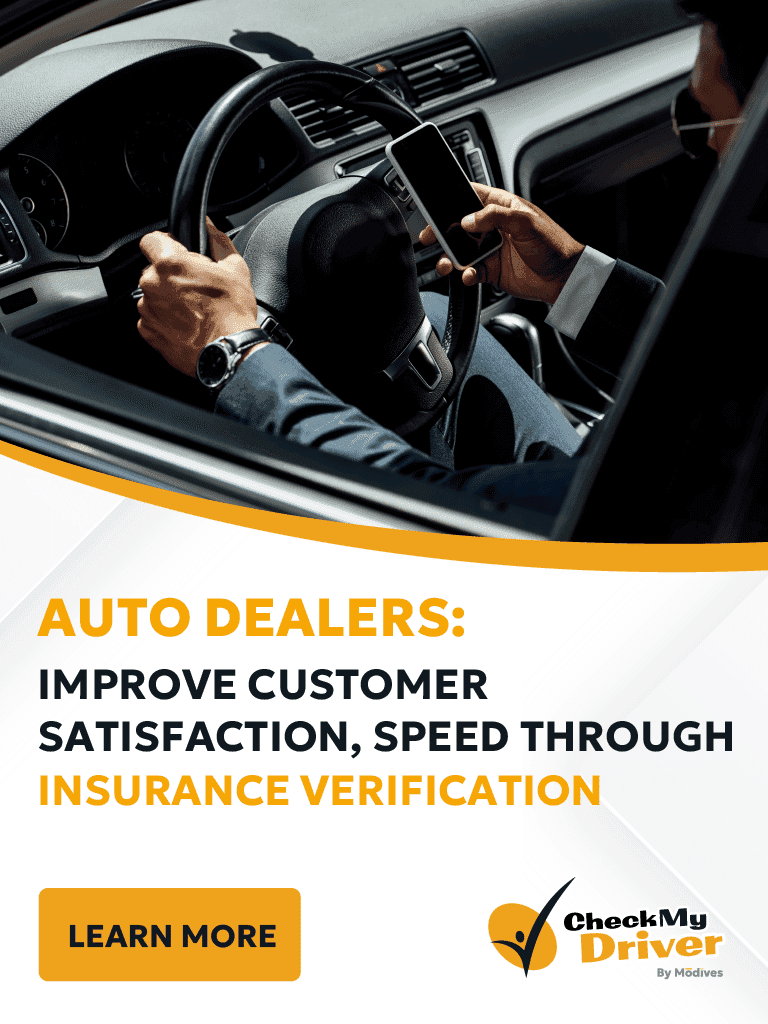According to data from the Insurance Information Institute, 14% of drivers— or nearly one in seven— is uninsured. But that crucial data point might not come to light until it’s too late to protect your auto dealership or service department.
To help protect your business, make sure you’re verifying that your customers’ insurance is active and adequate before you hand them the keys to test drive, pull their new auto off the lot, or take your service loaner for a spin.
Table of Contents
Why Dealerships Need to Verify Auto Insurance
As an auto dealer, it may be tempting to skip the time-consuming step of verifying your customer’s insurance. However, for better or worse, it’s a necessary part of the car selling process due to a few key reasons:
Legal requirements
The biggest reason most dealerships verify the customer’s insurance before completing an auto sale is to comply with the law. While exact requirements vary by state, all drivers are legally required to have liability insurance in order to be on the road. Therefore, auto dealers conduct verification to avoid incurring penalties from unknowingly selling to uninsured drivers.
Financial risk mitigation
For auto lenders and leasing companies, insurance verification is about more than just following regulations. Rather, because they have a vested interest in the vehicle, they need to ensure that it’s adequately protected. Otherwise, uncovered damage may end up coming back to them.
Customer protection
Auto insurance can be expensive, but not as expensive as an uncovered incident. Many consumers tend to focus on the short-term while dismissing the bigger picture. For instance, if a driver thinks their insurance rates are too high, they may cancel their policy to get out of a $200/month payment at the risk of a $10,000 car repair bill if they get into a collision. Dealerships prevent this short-sighted decision-making by posing insurance requirements prior to a vehicle purchase.
How missing insurance in the car sales process can cost dealerships
Although verifying insurance is a standard step in the car buying process, fewer dealerships check coverage before a test drive. Unfortunately, skipping this step introduces the possibility of lending vehicles to uninsured drivers and can lead to major consequences.
For example, imagine this scenario: Gabe hadn’t been driving much over the past few years while he was living in the city, but now that he’s moving out to the suburbs for his new job, he needs to buy a car. While he’s looking around to see what he wants, he doesn’t want to pay for car insurance, instead just flashing his old insurance card from when he was covered under his parents’ policy during college.
Each dealership Gabe visits has no problem making copies of his driver’s license and the old insurance card, and Gabe loves test driving all these new cars.
Until one rainy day, when Gabe takes a high-end electric vehicle out for a spin. He misses the car merging into his lane, swerving out of the way at the last minute and injuring a pedestrian in a crosswalk before smashing into a pole.
Luckily Gabe was only driving at low speed, so both he and the pedestrian walked away with only minor injuries. But since he wasn’t covered under an auto insurance policy, the dealership could be on the hook for damage to the expensive vehicle and injuries to the pedestrian—bills that could really rack up!
That’s the risk auto dealerships run when they don’t verify with carriers that a driver’s insurance is both active and adequate. An insurance card, deck page, or other proof of insurance isn’t good enough—you need insurance verification you can trust before you hand over the keys.
What Is Insurance Verification?
Insurance verification for auto dealerships is the process of checking that a test driver’s, buyer’s, or service customer’s auto insurance is both active and adequate. This process is conducted by reaching out to the consumer’s auto insurance company, which can be time-consuming and aggravating for those at the auto dealership or in its service department.
How dealerships verify insurance
The current process of verifying auto insurance is surprisingly clunky. Typically, the customer will provide physical proof of auto insurance in the form of an insurance card or declaration page. Then, someone from the auto dealership’s finance and insurance office manually calls the consumer’s insurance carrier, often waiting on hold for at least 15 minutes to talk with someone in the insurance company’s call center— and that’s assuming someone picks up on the first call.
Once the F&I manager gets a hold of an insurance agent, they’ll request an insurance binder, which contains details about the driver’s auto insurance policy and what it covers. From there, they’ll review the documents to confirm that the customer’s coverage meets the dealership’s requirements. All in all, this process typically takes 30 to 45 minutes, during which the customer is waiting to get their keys.
CheckMy Driver, Modives’ solution for auto dealerships and their service departments, offers a consumer-driven and intuitive insurance verification process to consumers in a fraction of the current wait time through its automation.
Where today’s process falls apart
There are many different flavors of how car dealerships gather proof of insurance for their customers, but many only do so at the point of purchase rather than any of the other vital steps in the process.
For example, the dealership in the hypothetical above would benefit from verifying insurance before letting shoppers take their autos out on a test drive. The same could be said of service departments handing out loaners without verifying insurance with the customer’s carrier.
The danger of skipping insurance verification when loaning a car
Many dealerships have shared stories similar to the following: Mia brings in her ten-year-old car for repairs and is handed the keys to a loaner after the service representative takes a cursory glance at the screenshot of an insurance card on her phone.
However, Mia’s coverage is below the state minimums, which in her state are low compared to the national averages. Her teenage son takes the loaner out for a joy ride and ends up totaling it, with the cost to repair far exceeding Mia’s coverage and the value of her old, broken car combined.
The dealership’s only choice is to eat the cost of the totaled loaner, with the busted old car sitting on a corner of the lot for years after.
Insurance verification vs. auto loan approval
Many auto sales require financing, which can lead to some confusion among car buyers between insurance verification and the loan approval process.
While verifying a driver’s insurance requires auto insurance policy details, auto loan applications require more in-depth financial details. In addition to basic personal information like a valid driver’s license and social security number, customers often need to provide their credit score, banking history, and proof of income.
If your dealership provides auto financing options, it’s important to be clear about what information you need for each purpose to ensure transparency in the buying process.
What Car Dealerships Should Consider for Insurance Verification
There are several steps car dealerships and service departments can take to make the insurance verification process easier and still provide better protection for their business than today’s systems:
- Proof ≠ Insurance: Dealerships and service departments can’t depend on their customers’ ID cards, declaration pages, or other “proof” of insurance to cover business risks during the sales and service processes. Make sure the insurance is verified to be both active and adequate through the customer’s auto insurance provider.
- Verify Before It’s Too Late: Don’t wait until the last minute to verify that insurance is active and adequate with the customer’s auto insurance company, because you could hit a snag that kicks your deal—or at least delays it. Instead, check early in the process as the sale progresses to line everything up for later success.
- Monitor to Avoid Surprises: It’s incredibly easy for your customer to cancel his or her insurance the day after you check that it’s active and adequate in order to save a couple bucks. If they’re going to be holding onto your loaner or test drive for an extended period of time, make sure that you’re verifying that the insurance remains active and adequate throughout that period to get the transparency you need to keep your business safe.
The Solution: How CheckMy Driver Solves Auto Insurance Verification
The steps to building an effective insurance verification process may seem difficult and time consuming, but the good news is that CheckMy Driver makes insurance verification and monitoring easy.
Through CheckMy Driver’s automated and consumer-driven process, dealerships and service departments can cut down on hours of frustrating work while still getting vital visibility into their customers’ insurance coverage.
Our patent-pending technology enables car dealerships to conduct digital insurance verification to confirm that their customers’ information is active, accurate, and adequate. Your customer can start the process by opening a link or scanning a QR code.
From there, they’ll sign into their insurance carrier, and CheckMy Driver’s adequacy engine will pull their policy information directly from the insurer and review it against your dealership’s requirements. Once it’s finished, you and your customers will receive the results in an easy-to-read report.

This streamlined digital process eliminates the need for your team to contact your customer’s insurance provider. Instead, it pulls real-time data straight from the source to keep sensitive data out of your hands and reduce wait times by up to 30 minutes.
Learn more about CheckMy Driver or sign up today!



